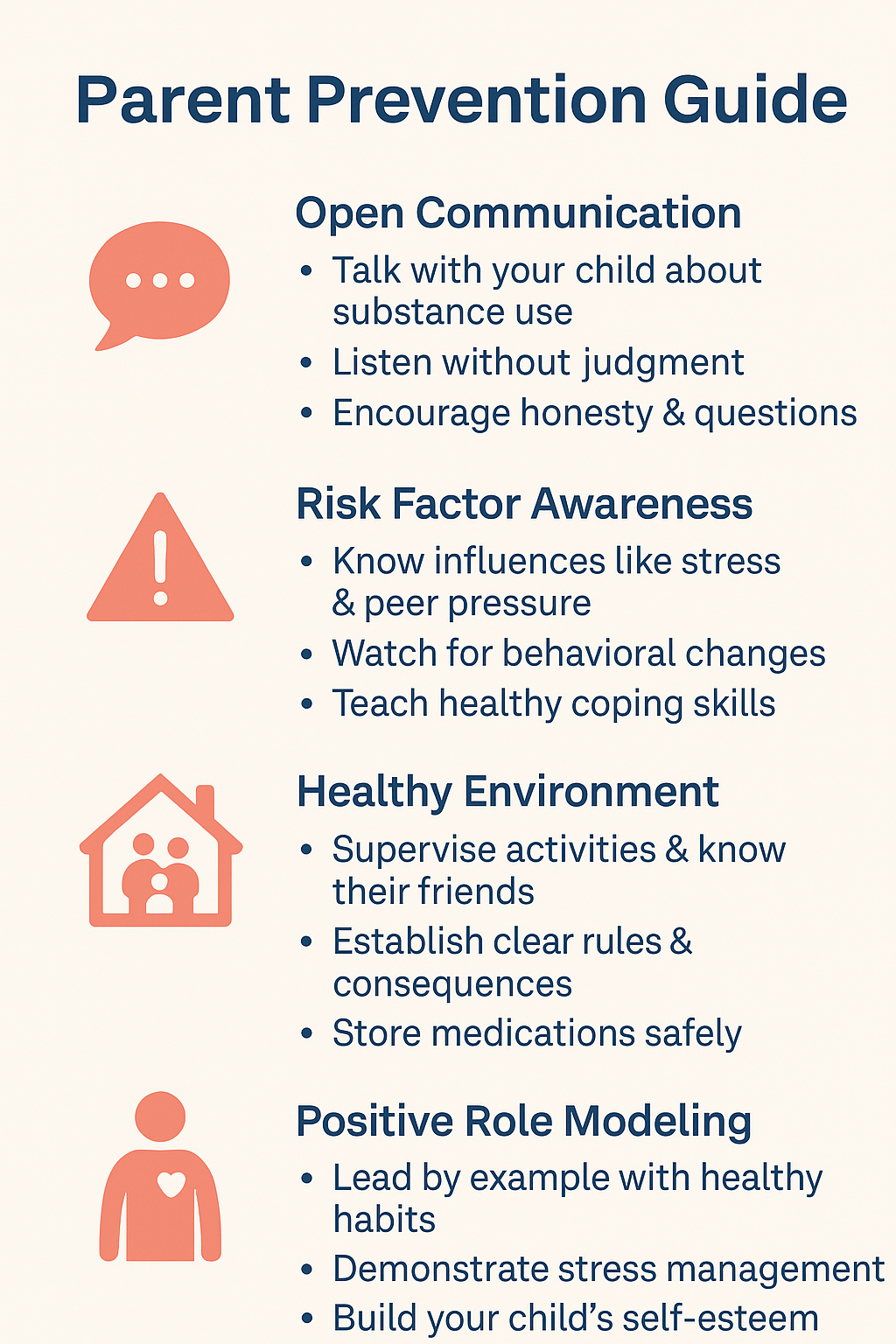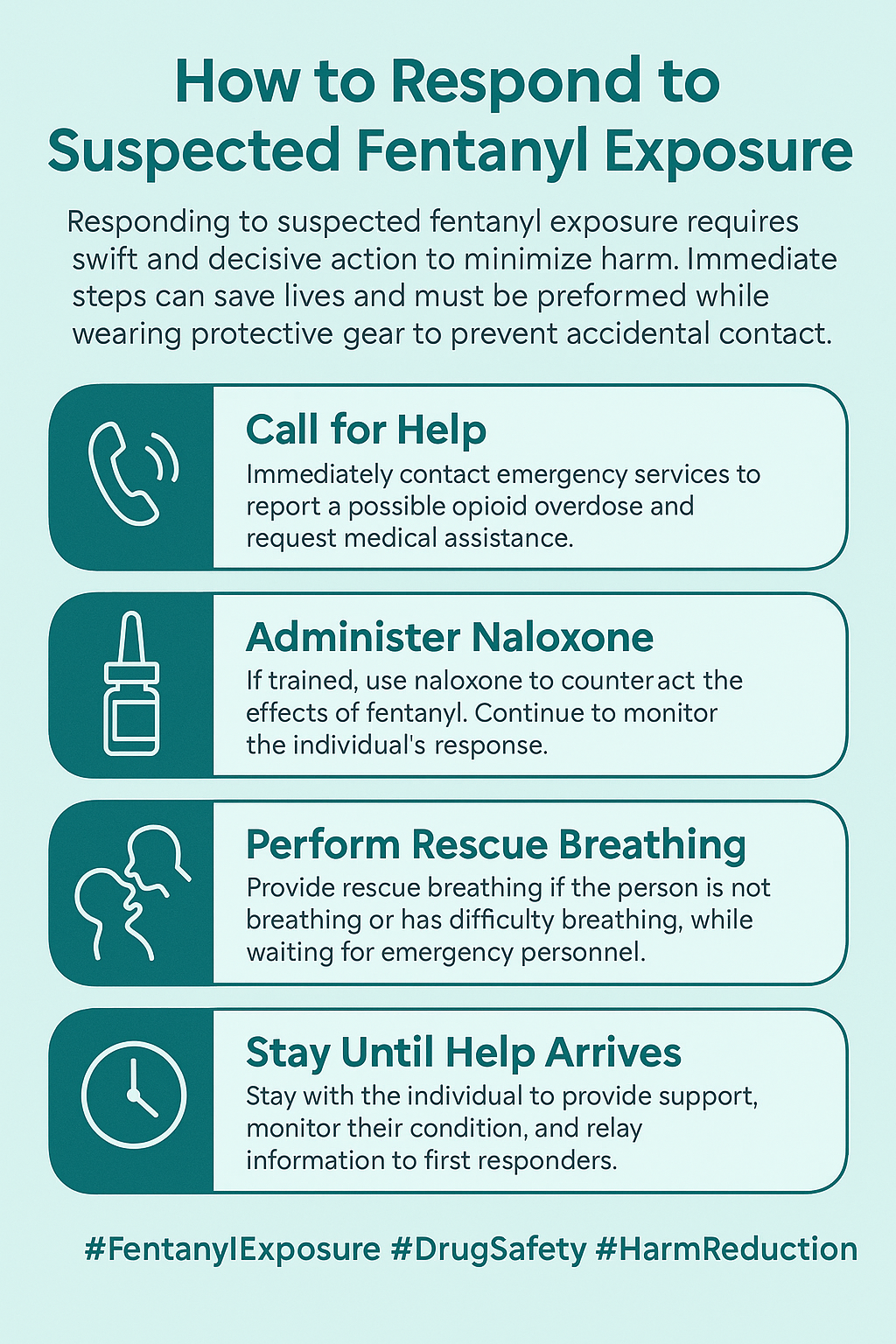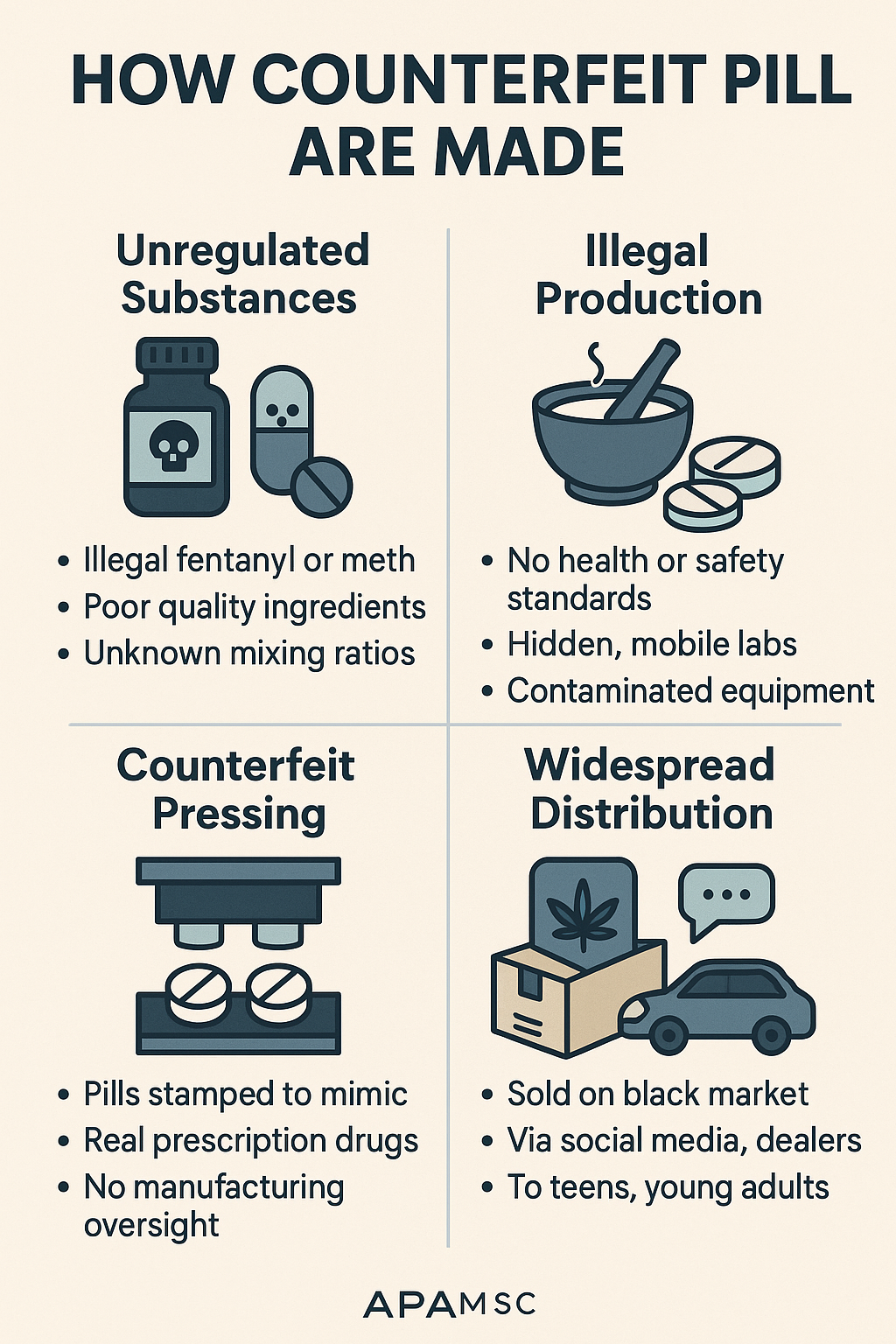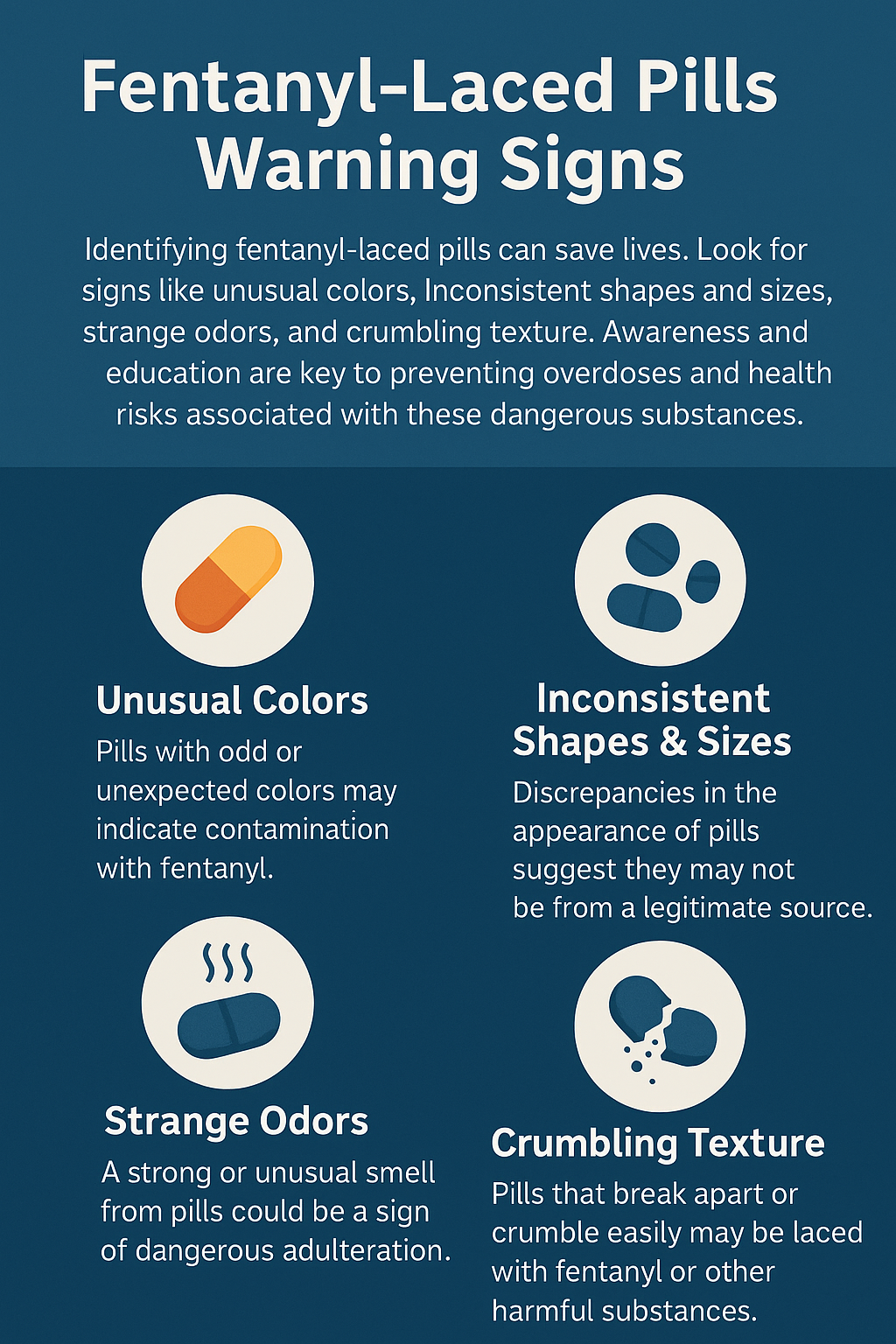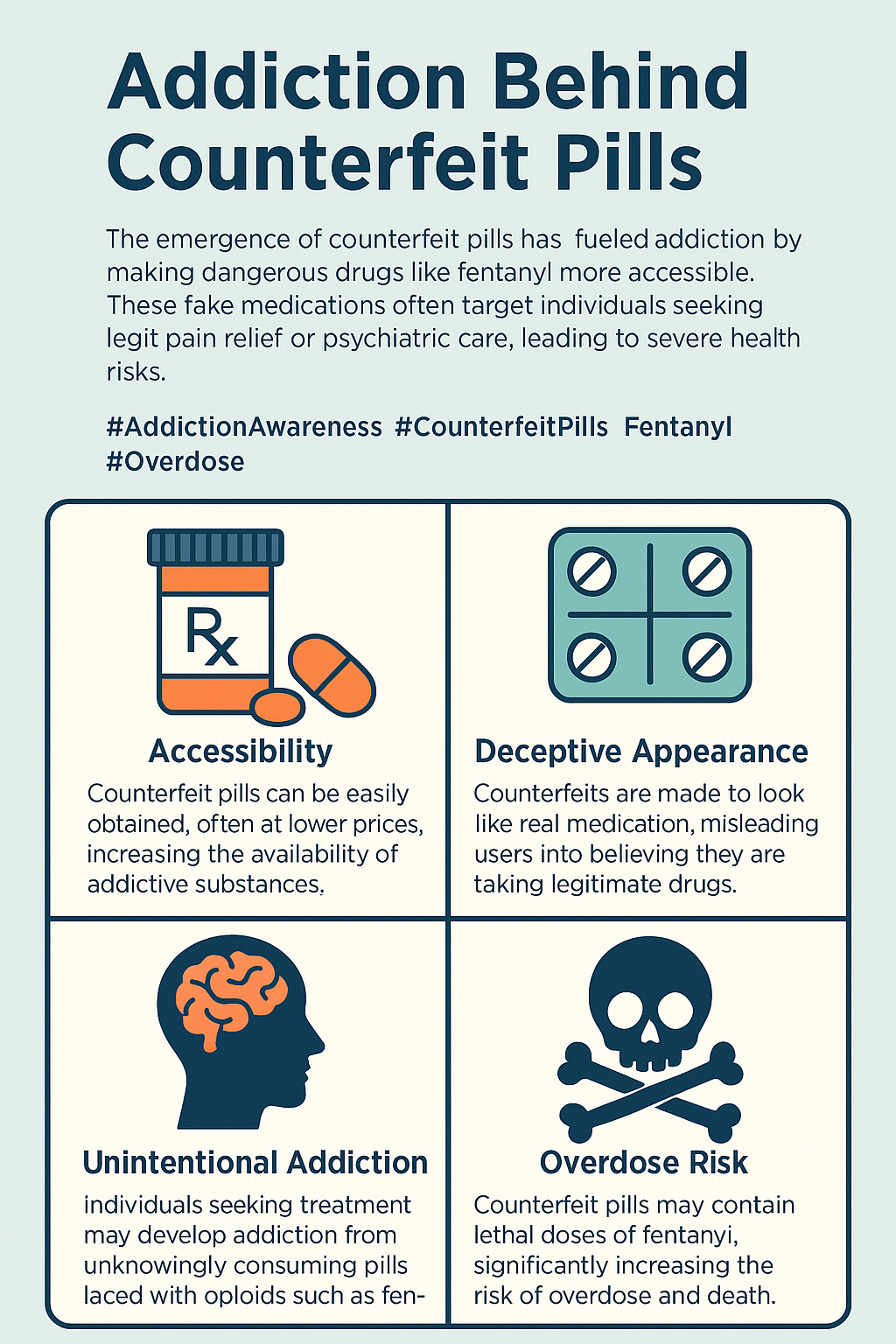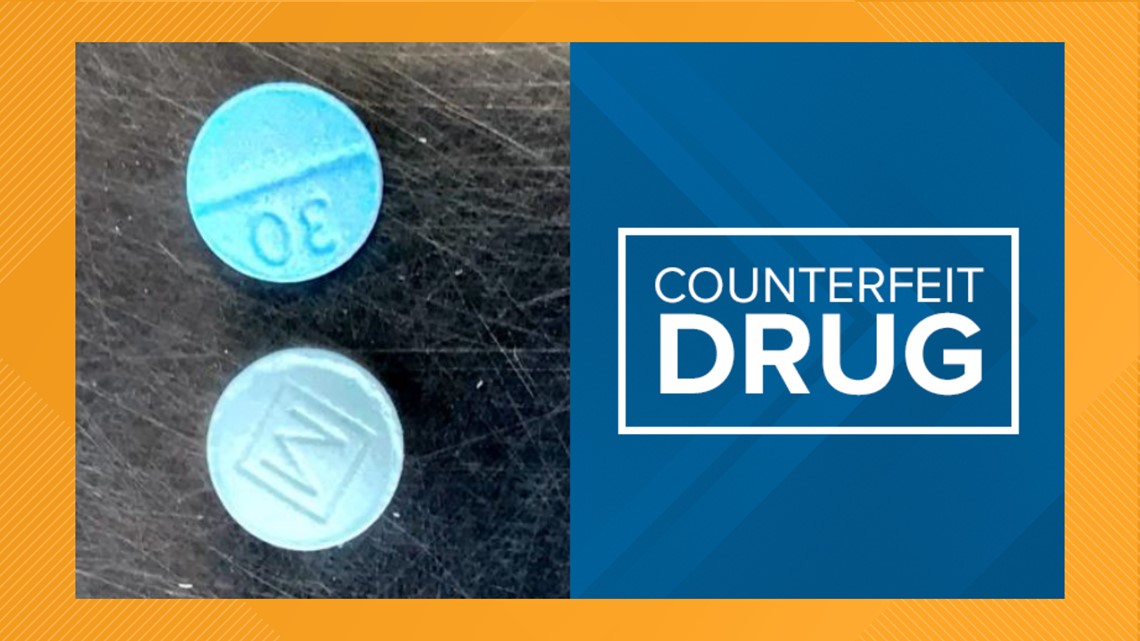Counterfeit medications laced with substances like fentanyl pose major health risks. Limited access to legitimate drugs drives their use. Prevention requires regulation, self-management, family support, and community resources to promote education, harm reduction, and treatment.
The Hidden Dangers of Counterfeit Pills and Their Addictive Potential
What Are Counterfeit Pills? Counterfeit pills are fake medications illicitly manufactured to look like legitimate prescription drugs. These pills often mimic widely prescribed medications such as opioids (e.g., oxycodone or hydrocodone), benzodiazepines (e.g., Xanax), and stimulants (e.g., Adderall).
Why Counterfeit Pills Are Addictive? Counterfeit pills frequently contain highly addictive substances, often without the user’s knowledge. Some of the most common substances found in these pills include:
- Fentanyl: A synthetic opioid 50-100 times more potent than morphine. Many counterfeit pills contain fentanyl because it is cheap to produce and requires only a small amount to create a strong effect.
- Methamphetamine: An addictive stimulant often found in counterfeit pills that mimic ADHD medications or party drugs.
- Other Adulterants: Counterfeit pills may also contain heroin or unregulated synthetic drugs, increasing their addictive potential.
Dangers of Counterfeit Pills
- Overdose Risk: Because these pills are unregulated, doses vary widely. A single counterfeit pill may contain a lethal dose of fentanyl.
- Unpredictable Effects: Some counterfeit pills contain no active drug, excessive amounts of a drug, or toxic fillers that can cause severe health complications.
- Rapid Addiction: Highly potent substances like fentanyl can lead to dependence quickly, even with minimal exposure.
Identifying Counterfeit Pills
- Often sold online or on the street.
- May have slight differences from real medications, such as incorrect size, color, or markings.
- Any medications purchased from unregulated sources carry a high risk of being counterfeit.
Prevention and Safety
- Only use prescription medications obtained directly from licensed pharmacies.
- Avoid taking pills from unknown individuals or purchasing medications online without a prescription.
- Educate individuals, especially young people, about the risks of counterfeit drugs, as they are increasingly targeted through social media and illicit online marketplaces.
- If addiction or exposure to counterfeit pills is suspected, seek help from a healthcare professional or addiction specialist immediately. Programs such as naloxone distribution can help reduce overdose deaths.
Counterfeit pills pose a significant threat to public health, leading to addiction and fatal overdoses. Awareness, education, and safe medication practices are essential in combating this growing crisis.
Managing the issue of counterfeit pills requires a comprehensive, multi-pronged approach by the government.
This includes enforcement, education, regulation, and harm reduction strategies to target the production, distribution, and consumption of counterfeit drugs.
Enhanced Law Enforcement and Border Control
- Crack Down on Production and Distribution: Strengthen law enforcement to identify and dismantle networks that produce and distribute counterfeit pills.
- Improve Border Security: Use advanced technologies like AI, X-rays, and chemical scanners to detect counterfeit drugs entering the country, particularly at ports and land borders.
- Target Online Markets: Collaborate with tech companies to monitor and shut down websites and social media platforms used to sell counterfeit pills.
Stricter Regulation of Pharmaceuticals
- Track-and-Trace Systems: Implement electronic systems to monitor the manufacturing and distribution of prescription drugs, making it harder for counterfeit pills to enter the supply chain.
- Tamper-Proof Packaging: Encourage pharmaceutical companies to use innovative packaging, such as holograms or QR codes, to verify authenticity.
- Tighter Control of Active Ingredients: Regulate the sale and transport of precursor chemicals used to manufacture counterfeit drugs, such as those used to synthesize fentanyl.
Public Awareness Campaigns
- Educate the Public: Launch campaigns to inform people about the dangers of counterfeit pills, emphasizing their risks and how to spot them.
- School and Community Programs: Include education on counterfeit pills in drug prevention programs for youth.
- Stigma Reduction: Reduce stigma around addiction to encourage individuals to seek treatment rather than turn to the black market.
Expand Access to Legitimate Medications
- Lower Prescription Drug Costs: Reduce the financial barriers to accessing legal medications, which often drive people to counterfeit alternatives.
- Increase Healthcare Access: Ensure broader access to healthcare, including pain management, mental health services, and addiction treatment.
- Streamline Prescription Processes: Simplify systems for obtaining necessary medications for those at risk of resorting to illegal sources.
Harm Reduction Measures
- Fentanyl Test Strips: Legalize and distribute test strips so users can detect fentanyl in counterfeit pills.
- Naloxone Availability: Expand access to naloxone (Narcan) to reverse overdoses caused by counterfeit pills.
- Supervised Consumption Sites: Consider implementing safe-use facilities where individuals can use substances under medical supervision, reducing overdose risks.
International Collaboration
- Cross-Border Cooperation: Work with foreign governments to regulate precursor chemicals and dismantle international trafficking networks.
- Global Standards: Participate in international efforts to standardize drug tracking and enforcement measures.
Data Collection and Research
- Real-Time Monitoring: Develop databases to track overdoses and counterfeit pill seizures, helping to identify emerging trends.
- Research on Counterfeit Markets: Invest in studies to understand the sources and distribution methods of counterfeit pills.
Key Challenges
- Balancing Enforcement and Support: Ensuring that efforts to combat counterfeit pills do not criminalize people with substance use disorders.
- Technological Challenges: Staying ahead of the sophisticated methods used by counterfeit manufacturers.
- Public Trust: Building trust in government programs, especially among vulnerable populations.
Through these measures, governments can reduce the reliance on counterfeit pills while promoting safer and more effective addiction treatment options.
Self-Management Strategies to Prevent the Use of Counterfeit Pills
Preventing the use of counterfeit pills requires self-awareness, self-regulation, and healthier coping mechanisms. Whether an individual is struggling with addiction or simply seeking safe medication use, these strategies can help mitigate risks.
1. Education and Awareness
- Understand the Risks: Learn about the dangers of counterfeit pills, including overdose and addiction, as they often contain lethal substances like fentanyl.
- Verify Medication Sources: Only obtain medications from licensed pharmacies or trusted healthcare providers, avoiding pills from unregulated sources.
- Know the Signs of Counterfeits: Be aware of discrepancies in pill size, color, markings, or packaging.
2. Develop Healthy Coping Mechanisms
- Manage Stress: Use mindfulness, meditation, deep breathing, or exercise to handle emotional triggers.
- Build Support Systems: Rely on friends, family, or support groups for encouragement.
- Engage in Hobbies: Pursue activities that provide purpose and satisfaction.
3. Seek Professional Help
- Substance Use Treatment: Work with addiction counselors or therapists to address underlying issues.
- Medication-Assisted Treatment (MAT): Consider options like methadone, buprenorphine, or naltrexone to reduce cravings.
- Pain Management Alternatives: Explore physical therapy, acupuncture, or cognitive-behavioral therapy if chronic pain is a trigger.
4. Enhance Decision-Making Skills
- Delay Impulses: Pause before making decisions about drug use to assess risks.
- Set Boundaries: Avoid environments where counterfeit pills or other substances are present.
- Identify Triggers: Keep a journal to recognize emotional or situational triggers and develop coping strategies.
5. Utilize Harm Reduction Tools
- Fentanyl Test Strips: Test substances for fentanyl to reduce overdose risk.
- Carry Naloxone: Have naloxone (Narcan) available as an emergency overdose reversal tool.
6. Focus on Long-Term Goals
- Set Personal Goals: Establish clear, achievable health, career, and personal aspirations.
- Track Progress: Celebrate milestones in avoiding counterfeit pills or reducing substance use.
7. Leverage Technology
- Mobile Apps: Use recovery apps to track habits and connect with sober communities.
- Online Resources: Join virtual recovery meetings or forums for support.
8. Build Resilience
- Practice Self-Compassion: Recognize that setbacks are part of the recovery process.
- Strengthen Mental Health: Seek therapy or counseling for anxiety, depression, or trauma that may contribute to substance use.
By implementing these self-management strategies, individuals can take proactive steps to avoid counterfeit pills and maintain overall well-being.
Family support plays a crucial role in preventing the use of counterfeit pills.
By fostering a supportive environment, improving communication, and providing guidance, families can help loved ones avoid the dangers of counterfeit drugs. Here are effective strategies to support prevention efforts.
1. Education and Awareness
- Learn About Counterfeit Pills: Educate yourself and family members on the risks, signs, and consequences of counterfeit pill use, including overdose and addiction.
- Share Knowledge: Discuss the dangers of counterfeit drugs with family members, emphasizing how they can be disguised as legitimate medications.
2. Open Communication
- Create a Safe Space: Foster non-judgmental communication so family members feel comfortable discussing their concerns.
- Listen Actively: Show empathy and understanding without interrupting or criticizing.
- Discuss Boundaries: Set clear expectations about medication use and emphasize obtaining drugs only from legitimate sources.
3. Monitor and Secure Medications
- Control Access to Prescription Drugs: Lock up medications and track quantities to prevent misuse.
- Dispose of Unused Medications: Use approved disposal programs to remove expired or unnecessary medications.
4. Promote Healthy Coping Mechanisms
- Encourage Stress Management: Support family members in managing stress through exercise, meditation, and hobbies.
- Model Positive Behavior: Demonstrate healthy habits and coping strategies to set a strong example.
5. Support Addiction Recovery Efforts
- Be Proactive: If a family member struggles with substance use, encourage professional help.
- Participate in Therapy: Join family therapy or support groups to learn how to provide effective support.
- Avoid Enabling: Set firm but compassionate boundaries that discourage substance use while offering love and support for recovery.
6. Foster a Supportive Environment
- Strengthen Family Bonds: Spend quality time together to create a sense of belonging and reduce isolation.
- Celebrate Achievements: Recognize milestones in avoiding substance use or counterfeit pills.
7. Identify and Address Risk Factors
- Watch for Warning Signs: Be alert to changes in behavior, such as secrecy, withdrawal, or financial struggles, which may indicate substance use.
- Address Underlying Issues: Support family members dealing with mental health challenges, trauma, or peer pressure.
8. Encourage Community and Peer Support
- Connect to Resources: Encourage participation in community programs, youth clubs, or addiction recovery groups.
- Provide Access to Information: Share resources about substance use prevention and counterfeit pill risks.
9. Promote Harm Reduction
- Discuss Harm Reduction: Educate at-risk family members about tools like fentanyl test strips and naloxone.
- Avoid Stigma: Treat substance use as a health issue, not a moral failing, to encourage help-seeking behavior.
10. Advocate for Broader Change
- Engage in Community Efforts: Support initiatives raising awareness about counterfeit pills.
- Support Legislation: Advocate for policies that improve access to addiction treatment, regulate counterfeit pill production, and lower prescription medication costs.
By implementing these strategies, families can create a supportive environment that reduces the risk of counterfeit pill use and promotes overall well-being.
Strengthening Communities to Prevent Counterfeit Medication Use
Preventing counterfeit medication usage requires strong community involvement and access to effective resources. Communities can implement strategies that educate, support, and protect individuals, ultimately reducing the risks associated with counterfeit drugs.
1. Education and Awareness Programs
- Public Campaigns: Launch community-wide initiatives to educate people about the dangers of counterfeit medications using social media, posters, and local events.
- School Programs: Partner with schools to teach students about counterfeit drug risks and safe medication use.
- Workshops and Seminars: Host events with pharmacists, healthcare providers, and law enforcement to provide practical advice on identifying and avoiding counterfeit pills.
2. Accessible Healthcare Resources
- Free or Low-Cost Clinics: Provide affordable healthcare to reduce reliance on unregulated sources for medications.
- Prescription Assistance Programs: Help individuals afford legitimate medications through subsidies or discount programs.
- Community Pharmacists: Engage local pharmacists to educate the community on how to verify medications and avoid counterfeit drugs.
3. Support for Vulnerable Populations
- Addiction Recovery Services: Expand access to treatment programs, including medication-assisted treatment (MAT), counseling, and support groups.
- Mental Health Services: Offer free or low-cost mental health resources to address underlying issues that may lead individuals to use counterfeit drugs.
- Harm Reduction Centers: Establish locations where individuals can access naloxone, fentanyl test strips, and other harm reduction tools.
4. Community Watch Programs
- Engage Neighborhoods: Encourage residents to report suspicious activity, such as counterfeit pill sales, to local authorities.
- Partner with Law Enforcement: Work with law enforcement to identify and address sources of counterfeit drugs in the community.
5. Safe Medication Disposal Programs
- Drug Take-Back Events: Organize regular events where people can safely dispose of unused or expired medications.
- Permanent Drop-Off Locations: Install medication drop boxes in public spaces, such as pharmacies and police stations.
6. Advocacy and Policy Support
- Legislation Advocacy: Support laws that strengthen penalties for counterfeit drug manufacturing and trafficking.
- Community Leaders: Engage local leaders to advocate for resources that combat counterfeit drugs and promote public safety.
7. Building Collaborative Networks
- Local Partnerships: Collaborate with healthcare providers, schools, businesses, and law enforcement to create a unified approach.
- Faith-Based Organizations: Partner with churches and religious groups to provide education and support within their communities.
- Peer Support Networks: Develop peer-led groups where individuals can share experiences and strategies to avoid counterfeit drugs.
8. Technology and Innovation
- Educational Apps: Promote apps that verify medication authenticity or provide information on safe medication use.
- Online Monitoring: Work with tech companies to identify and shut down websites or social media platforms selling counterfeit pills.
9. Emergency Preparedness
- Naloxone Distribution: Ensure widespread access to naloxone (Narcan) and train community members on how to use it in case of an overdose.
- Overdose Response Training: Provide education on recognizing and responding to overdoses, especially those caused by counterfeit pills containing fentanyl.
10. Promoting Alternative Coping Mechanisms
- Community Activities: Create recreational or skill-building programs to provide healthy outlets for stress and social connection.
- Support Groups: Host regular meetings for individuals recovering from substance use or facing mental health challenges.
Example Community Resources
- Local Health Departments: Offer programs like drug education, testing, and treatment services.
- Nonprofit Organizations: Groups like Narcotics Anonymous or other recovery organizations provide free support.
- Pharmaceutical Companies: Partner with legitimate manufacturers to support prescription discount programs.
By implementing these strategies, communities can empower individuals to make safer choices, reduce counterfeit drug exposure, and build a supportive network to address underlying issues related to substance use and medication access.
Conclusion
Counterfeit medication remains a significant public health threat due to its addictiveness and the dangers it poses to individuals and communities. Factors like high costs, limited access to legitimate drugs, and misinformation drive its use, often with devastating consequences. Addressing this issue requires a multifaceted approach: government regulation to curb production and distribution, self-management to promote informed choices, family support to guide and protect loved ones, and community resources to educate and offer harm reduction and treatment. By working collectively, these strategies can reduce the prevalence of counterfeit drugs and safeguard individuals from their harmful effects.
Video: Why Are Counterfeit Pills So Dangerous?
